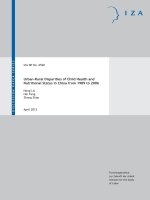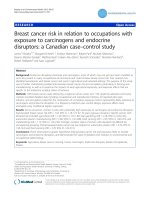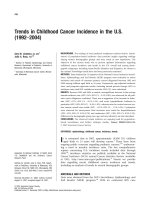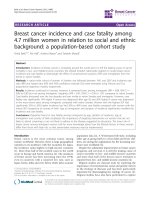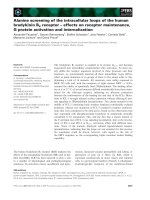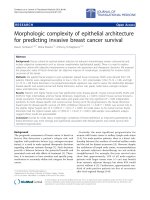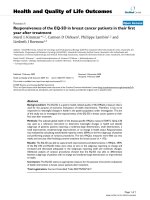Disparities of time trends and birth cohort effects on invasive breast cancer incidence in Shanghai and Hong Kong pre and postmenopausal women
Bạn đang xem bản rút gọn của tài liệu. Xem và tải ngay bản đầy đủ của tài liệu tại đây (934.08 KB, 7 trang )
Wang et al. BMC Cancer (2017) 17:362
DOI 10.1186/s12885-017-3359-5
RESEARCH ARTICLE
Open Access
Disparities of time trends and birth cohort
effects on invasive breast cancer incidence
in Shanghai and Hong Kong pre- and postmenopausal women
Feng Wang1, Lap Ah Tse1*, Wing-cheong Chan2, Carol Chi-hei Kwok3, Siu-lan Leung4, Cherry Wu5,
Oscar Wai-kong Mang6, Roger Kai-cheong Ngan6, Mengjie Li1, Wai-cho Yu7, Koon-ho Tsang8, Sze-hong Law9,
Xiaoping Miao10, Chunxiao Wu11, Ying Zheng11, Fan Wu11, Xiaohong R. Yang12 and Ignatius Tak-sun Yu1
Abstract
Background: Breast cancer is the leading cause of cancer morbidity among Shanghai and Hong Kong women,
which contributes to 20–25% of new female cancer incidents. This study aimed to describe the temporal trend of
breast cancer and interpret the potential effects on the observed secular trends.
Methods: Cancer incident data were obtained from the cancer registries. Age-standardized incidence rate was
computed by the direct method using the World population of 2000. Average annual percentage change (AAPC) in
incidence rate was estimated by the Joinpoint regression. Age, period and cohort effects were assessed by using a
log-linear model with Poisson regression.
Results: During 1976–2009, an increasing trend of breast cancer incidence was observed, with an AAPC of 1.73
[95% confidence interval (CI): 1.54–1.92)] for women in Hong Kong and 2.83 (95% CI, 2.26–3.40) in Shanghai. Greater
upward trends were revealed in Shanghai women aged 50 years old or above (AAPC = 3.09; 95% CI, 1.48–4.73).
Using age at 50 years old as cut-point, strong birth cohort effects were shown in both pre- and post-menopausal
women, though a more remarkable effect was suggested in Shanghai post-menopausal women. No evidence for a
period effect was indicated.
Conclusions: Incidence rate of breast cancer has been more speedy in Shanghai post-menopausal women than
that of the Hong Kong women over the past 30 years. Decreased birth rate and increasing environmental
exposures (e.g., light-at-night) over successive generations may have constituted major impacts on the birth cohort
effects, especially for the post-menopausal breast cancer; further analytic studies are warranted.
Keywords: Breast cancer, Annual percentage change, Incidence, Age-period-cohort modeling
Background
Breast cancer is now the most common cancer in
women worldwide, especially in the metropolises [1].
Hong Kong and Shanghai, being the most westernized
and urbanized cities in China, have presented the
* Correspondence:
1
JC School of Public Health and Primary Care, the Chinese University of
Hong Kong, Sha Tin, Hong Kong SAR, China
Full list of author information is available at the end of the article
highest incidences of breast cancer among China. Breast
cancer is the top one malignancy and accounts for 20–
25% of new cancer cases among women in these two cities [2, 3]. Although the incidence rate of breast cancer
in Hong Kong and Shanghai are nearly 2-folds lower
than that in the United States [4], these rates have increased faster than global rate [5].
In the most recent decades, Hong Kong and Shanghai
successively underwent an accelerating socioeconomic development, which is reflected in many aspects including
an adoption of western lifestyle, changes of reproductive
© The Author(s). 2017 Open Access This article is distributed under the terms of the Creative Commons Attribution 4.0
International License ( which permits unrestricted use, distribution, and
reproduction in any medium, provided you give appropriate credit to the original author(s) and the source, provide a link to
the Creative Commons license, and indicate if changes were made. The Creative Commons Public Domain Dedication waiver
( applies to the data made available in this article, unless otherwise stated.
Wang et al. BMC Cancer (2017) 17:362
pattern and ageing of their population [6, 7]; these are the
established risk factors that may have contributed greatly
to the increasing rate of breast cancer incidence. Given
different health policy and political background between
Shanghai and Hong Kong, in particular the performance
of unique birth control policy in mainland China over the
past 30 years, the risk patterns of breast cancer for women
in these two cities may exist large discrepancies.
Previous time trend studies on breast cancer were
based on the overall analysis that might have masked the
actual trends of pre-menopausal (early age onset) and
post-menopausal breast cancer, between they represent
different disease entities with various etiology [4]. A separate analysis of time trend by menopausal status is thus
regarded as proper for disclosure of actual risk patterns.
This study described the temporal trend of breast cancer
among Hong Kong and Shanghai women and assessed
the potential effects contributing to the increasing trend
in pre- and post-menopausal breast cancers by using a
novel approach of age-period-cohort modeling (APC)
developed by Rutherford et al. [8].
Methods
Data sources
Data on newly diagnosed invasive breast cancer were retrieved from the Hong Kong Cancer Registry (HKCaR)
(Data is available: and
Shanghai Cancer Registry (SHCaR) (Data is available
from the ‘Tumor Annual Report of Shanghai’), which
both are accredited members of the International Association of Cancer Registries (IACR). Briefly, these two
cancer registries are population-based cancer registries.
The completeness and quality of data was reported an
over 95% coverage of most cancers for HKCaR, and
coverage of cancer cases registered by SHCaR is nearly
100% [2, 3].
Population data during the corresponding period was
obtained from the Hong Kong Census and Statistics Department (Data is available: />hkstat/sub/so20.jsp) and Shanghai Statistics Bureau
(Data is available from the ‘Shanghai Statistical Yearbook’). Mid-year population data were employed in the
calculation of the incidence rate.
Statistical analysis
Age-standardized incidence rates were calculated by
using the direct method and taking the WHO world
standard population 2000 as the reference population.
Because of the small number of breast cancer diagnosed
in women younger than 20 years, these cases were excluded from all analyses. We stratified the cases into
pre- and post-menopause subgroups using a cut-point of
50 years old that is the median age at menopause among
Chinese women [9]. So all grouped age-standardized
Page 2 of 7
rates were calculated as truncated rates. Trend of breast
cancer incidence was evaluated by the JoinpointRegression Program (Version 4.1.0, Statistical Research
and Applications Branch, National Cancer Institute,
USA). Joinpoint regression identifies statistically significant trend change points (joinpoints) and the rate of
change (average annual percent change, AAPC).
Age-period-cohort modeling is a useful framework to
understand the temporal trend of key diseases’ prevalence and estimate the effects of three time-dependently
scales - age, diagnostic period and birth cohort. A fundamental issue of APC is the linear dependence among
age, period and cohort effects, which limited to obtain
the unique effect of each time-dependent variable [10,
11]. We employed a new age-period-cohort modeling
method which developed by Rutherford et al. [8] to investigate the effects of age, period and cohort on the incidence of breast cancer. This novel method overcomes
the over-dispersion amongst time-dependent variables
by fitting a log-linear model with a Poisson distribution
to obtain ‘unbiased’ age, period and cohort effects in the
same model. R-statistical software was used for trend
analysis (Epi package version1.1.67, R version 3.1.1),
while other statistical analyses were performed with the
Statistical Package for the Social Sciences (SPSS) version
20.0 (IBM Corp, Somers, NY). A p value of <0.05 was
regarded as statistically significant.
Results
The present analyses were based on 48,367 (Hong Kong)
and 44,344 (Shanghai) cases of invasive breast cancer reported from all hospitals from 1976 to 2009. The age
standardized incidence rates of breast cancer in Hong
Kong women increased from 28.6 to 54.9/100,000
women which were always higher than those in Shanghai women (from 17.8 to 44.0/100,000 women) during
the study period (Fig. 1). The AAPC were 1.73 [95%
confidence interval (95% CI), 1.54–1.92] for Hong Kong
which is lower than that for Shanghai (AAPC = 2.83,
95% CI, 2.26–3.40) (p < 0.01). Incidence rates by age and
diagnostic period are shown in Table 1.
The incidence trends were inconsistent in Hong Kong
and Shanghai women after stratified by age (Fig. 2). The
increasing trends were similar for Hong Kong and
Shanghai women aged among 20–49 years-old
(p = 0.58), with an AAPC of 2.06 (95% CI, 1.81–2.32,
Hong Kong) and 2.64 (95% CI, 1.89–3.41, Shanghai), respectively. However, the increasing trend of Shanghai
women who were 50 years-old or above was more
speedy (AAPC = 3.09, 95% CI, 1.48–4.73) than that of
Hong Kong women (AAPC = 1.29, 95% CI, 0.85–1.73)
(p < 0.01).
Results of the goodness-of-fit for the models of age,
period and cohort are shown in Fig. 3 and Additional file
Wang et al. BMC Cancer (2017) 17:362
Page 3 of 7
Fig. 1 Age-standardized incidence rates for breast cancer among Hong Kong and Shanghai women, 1976–2009
1: Table S1. Age and cohort effects contributed significantly to the increasing trends, although the contribution of period effect couldn’t be entirely neglected. The
age and period effects on breast cancer trends were
similar between Hong Kong and Shanghai women in
both groups. For the younger cases (age 20–49 years
old), the cohort effect of Hong Kong women was quite
similar as that of Shanghai women. Their relative risks
(RR) increased in a similar magnitude for women born
before 1961 (left part of Fig. 4, using the 1961 birth cohort as reference). For the elder cases (age ≥ 50 years
old), the cohort effect of Shanghai women was more
remarkable that of Hong Kong women, with a higher RR
(0.15 to 2.31) for the most recent generation in Shanghai
women than their counterparts in Hong Kong (0.28 to
1.80) (right part of Fig. 4, using the 1926 birth cohort as
reference). There was no evidence for a significant
change of relative risk for the period effects.
Discussion
Breast cancer is the most common malignant tumor
among Chinese urban women. The highest rates occur
in eastern coastal urban areas that are socioeconomically
well developed [1]. Our data demonstrated an average
Table 1 Age-specific incidence rates (per 100,000 women) of breast cancer in Hong Kong and Shanghai, 1976–2009
Age
group
Shanghai
Hong Kong
1976–80
1981–85
1986–90
1991–95
1996–00
2001–05
2006–09
1976–80
1981–85
1986–90
1991–95
1996–00
2001–05
2006–09
20–24
0.76
0.64
0.89
0.91
0.52
1.00
1.13
1.55
1.38
1.73
1.97
1.25
0.84
1.14
25–29
3.11
2.80
3.90
3.38
4.52
5.78
3.88
5.84
6.68
6.24
5.24
7.13
5.85
5.84
30–34
11.47
11.15
13.78
15.03
11.95
12.20
12.80
15.11
15.90
17.96
19.30
21.30
18.19
21.45
35–39
21.20
26.37
30.68
33.48
33.54
27.19
29.98
34.64
35.59
43.28
44.22
46.90
46.39
49.89
40–44
36.52
47.01
61.33
53.67
72.01
75.18
65.63
43.07
52.37
78.59
71.78
88.30
94.46
98.95
45–49
43.78
45.96
70.20
78.51
87.79
121.45
117.36
65.34
73.62
78.02
98.24
113.95
129.20
144.66
50–54
45.92
48.34
64.86
71.89
97.14
124.51
125.84
73.28
71.33
78.40
88.81
115.59
124.18
152.04
55–59
48.40
45.86
62.41
71.32
90.87
120.44
123.09
79.21
90.37
77.06
84.47
116.14
136.75
148.46
60–64
58.09
56.62
61.63
75.79
96.28
102.66
134.51
103.12
92.23
95.78
90.88
98.08
120.66
150.10
65–69
47.23
59.82
69.06
70.55
87.00
106.73
127.36
133.94
109.43
121.41
101.61
103.75
113.68
129.84
70–74
53.67
58.14
72.41
79.57
89.75
116.53
126.62
113.92
131.46
123.06
118.38
118.12
118.96
126.27
75–79
44.84
60.48
64.76
70.76
88.31
109.77
120.91
120.63
120.82
131.89
130.87
132.63
130.41
130.53
80–84
53.64
62.68
67.05
71.68
91.93
116.32
101.84
87.06
114.12
142.96
162.43
167.18
150.61
148.07
≥85
62.86
44.27
53.00
60.90
80.62
83.14
96.30
122.91
114.09
136.32
156.57
172.06
149.22
146.81
Overall
18.78
20.53
26.08
28.06
33.86
41.34
42.35
32.35
33.34
36.69
37.95
43.73
46.87
52.38
Wang et al. BMC Cancer (2017) 17:362
Page 4 of 7
Fig. 2 Age-specific incidence rates for breast cancer by 50 years-old among Hong Kong and Shanghai women, 1976–2009
annual increase of 1.73% and 2.83% in the incidence rates
of invasive breast cancer among Hong Kong and Shanghai
women for the calendar period 1976–2009. Of note, this
increase was more remarkable in post-menopausal women
of Shanghai (AAPC = 3.09), whilst the trends of premenopausal breast cancer incidence rate were similar
among Hong Kong and Shanghai women. Stronger birth
cohort effects were indicated in the most recent generations for the post-menopausal breast cancer cases in
Shanghai than those of the Hong Kong.
The increasing trends of breast cancer incidences
among Hong Kong and Shanghai women are parallel
with the fast socioeconomic development and
urbanization of these cities. The strong birth cohort
Fig. 3 Age-period-cohort effect analysis of breast cancer among Hong Kong and Shanghai women. Curves (red and black) in left side showed
age-specific incidences of breast cancer; Curves in middle part showed cohort effects; curves in right side showed period effects
Wang et al. BMC Cancer (2017) 17:362
Page 5 of 7
Fig. 4 Age-period-cohort trends analysis by 50 years-old among Hong Kong and Shanghai women. Curves (red and black) in left side showed
age-specific incidences of breast cancer; Curves in middle part showed cohort effects; curves in right side showed period effects
effect observed in Shanghai and Hong Kong women
was consistent with studies conducting in other Asia
countries [12–15]. Decreased birth rate and late age
at first birth, westernized lifestyle and possible environmental exposures [e.g., endocrine disrupting chemicals (EDCs)] between women born in successive
cohorts may have contributed to the upward trends
in incidence rate of breast cancer [16]. With the development of economics, the reproductive pattern of
Hong Kong and Shanghai women changed significantly in the recent half century. In Hong Kong, age
at first birth postponed for about 5 years (25.1 years
old in 1981 v.s. 30.0 years old in 2011); Parity decreased from 3.73/woman born in 1936 to 1.56/
woman born in 1961, which linked to an increase in
the nulliparity rate from 8.1% for women born in
1936 to 22.5% for women born in 1961 [17]. As an
indicator of productive pattern, the total fertility rate
(TFR) of Hong Kong decreased to 1.06 in 2009.
Similar situation also occurred among Shanghai
women [17, 18]. The urban Shanghai has the lowest
TFR worldwide [1]. It was reported that decreased
numbers of births per woman have been associated
with an increased risk of breast cancer (odd ratio
1.45) for post-menopausal women in Shanghai [19].
The low birth rate observed in both Shanghai and
Hong Kong women over the past 30 years might
have contributed greatly to the cohort-driven trend
of post-menopausal breast cancer in later years.
Considering there were two decades later between
Hong Kong and Shanghai whose TFR was less than
1, it could be projected that the incidence trend
might keep increasing in the post-menopausal
women of Hong Kong.
Obesity, lack of physical activity and excessive alcohol
also are known risk factors of breast cancer [16]. The
prevalence of overweight slightly increased from 33.7% in
1995 to 35.9% in 2005 among Hong Kong women [20],
while more than one third of female adults were overweight
or obesity in Shanghai [21]. On the other hand, the alcohol
drinking rate of women increased 5.1% from 2005 to 2010
(19.5% and 24.6%, respectively) in Hong Kong [20]; meanwhile, a survey in 2007 showed that less than 50% female
attended moderate physical activity once per week. These
changes in lifestyles may also yield impacts on the increasing trends of breast cancer incidence.
Emerging environmental risk factors that catch the
public’s attention are the disrupted circadian rhythm induced by light at night (LAN) and exposure of environmental endocrine disruptors. Night shift work, as a
typical surrogate of circadian rhythm disruption, has
been classified as the Group 2A carcinogen by the International Agency for Research on Cancer (IARC) [22].
Prolonged exposure to night shift work is evident to be
associated with an increased risk of female breast cancer,
showing a dose-response relationship with night shifts
experienced [23]. The hypothesized mechanism is that
LAN suppresses the production of melatonin which increased incident breast cancer [24]. Apart from high
prevalent night shift work, Hong Kong and Shanghai
have high nighttime illumination. And it has very high
building density and close proximity of commercial and
residential premises. The outdoor light can easily penetrate into bedrooms when people turn off their
Wang et al. BMC Cancer (2017) 17:362
household electric light. LAN exposure might be a potential risk of female breast cancer.
Evidence showed that prenatal exposure to environmental endocrine disruptors such as dioxin and polychlorinated biphenyls (PCBs) increased risk of human
breast tumors [25]. Meanwhile, serum level of dioxin
was positively related with breast cancer incidence [26].
Environmental dioxin and PCBs can accumulate in animal fatty tissues and readily be absorbed into human
body, which is the major source of human exposure to
these compounds. Fish consumption is very high in the
eastern coastal areas of China. A recent report documented that about 3.1% Hong Kong population consumed exceeded dioxin and dioxin-liked PCBs from
food, in particular fish [27], which might be partly contributed to the increasing trend of breast cancer in Hong
Kong female population.
Mammography screening as a diagnostic practice
may contribute to the period effect, but it should not
be a major concern. Hong Kong started to promote
mammography screening from earlier 1990s, but there
was no population screening till now [28]. The less
intensive promotion of mammography among young
women might artificially increase the breast cancer
incidence at the young age group but no obvious upward in period effect was suggested. Moreover, the
period curvature was plateau, which further supports
that the increasing trend is more likely to reflect the
actual secular trend rather than an artificial one. A
significant change was seen in the ductal carcinoma
in situ (DCIS). The diagnosed DCIS increased from
<1% in 1980s to 11% in 2010s among all breast cancer patients (unpublished data). Nevertheless, DCIS
wasn’t included in the current analyses.
A deceleration for birth cohort later than 1960 in
Hong Kong was reported by Wong IO et al., who
explained this by the cap in the population effects
from socioeconomic development [29]. We observed
a similar trend to that of the Shanghai women, and
thus considered that a decreased cohort effect for
the birth cohort 1960 and thereafter might be an
artificial issue that may not reflect the socioeconomic development, because women of these birth
cohorts were too young to reach the peak age of
breast cancer occurrence.
Conclusions
This study revealed that the time trends of breast cancer
incidence kept increasing among Hong Kong and Shanghai women. Decreasing birth rates and later age at first
birth might have contributed to the increasing rate, in
particular the post-menopausal breast cancer incidence.
Moreover, emerging environmental risk factors, such as
disruption of circadian rhythm induced by prolonged
Page 6 of 7
exposure to light at night and exposure to environmental endocrine disruptors might also contribute to the increasing trends of breast cancer incidence for both
Shanghai and Hong Kong women. Nevertheless, hypotheses raised from this descriptive epidemiological research should be confirmed by future analytic studies.
Additional file
Additional file 1: Table S1. summary statistics of age-period-cohort
effect modelling in breast cancer incidences among Hong Kong and
Shanghai women, 1976–2009. (DOC 32 kb)
Abbreviations
APC: Age-period-cohort modeling; HKCaR: Hong Kong Cancer Registry;
SHCaR: Shanghai Cancer Registry; IACR: The International Association of
Cancer Registries; AAPC: Average annual percent change; RR: Relative risks;
EDCs: Endocrine disrupting chemicals; TFR: Total fertility rate; LAN: Light at
night; IARC: The International Agency for Research on Cancer;
PCBs: Polychlorinated biphenyls; DCIS: Ductal carcinoma in situ
Acknowledgements
Not applicable.
Funding
This work was supported by Direct Grants for Research of the Chinese
University of Hong Kong (Project number 2012.2.034) and Research Grants
Council of Hong Kong [Grant number 474811]. The funding sources had no
role in the study design, data collection, data analysis, or interpretation of
the findings.
Availability of data and materials
Not applicable.
Authors’ contributions
FW and LT raised the main hypothesis; FW drafted the manuscript; FW, CK,
and ML performed the statistical analyses and generated tables and figures;
OM, RN, YZ and FW coordinated the data collection and quality control of
the project; ML and CW verified the result of data analysis; LT, WC, SL, CW,
WY, KT, SL, XM, XY, and IY critically reviewed the manuscript. All authors read
and approved the final manuscript.
Competing interests
The authors declare that they have no competing interests.
Consent for publication
Not applicable.
Ethics approval and consent to participate
Cancer incident data was retrieved from the Hong Kong Cancer Registry
(HKCaR) and Shanghai Cancer Registry (SHCaR). Population data obtained
from the Hong Kong Census and Statistics Department and Shanghai
Statistics Bureau. All these data are publicly published and can be used
without approval.
Publisher’s Note
Springer Nature remains neutral with regard to jurisdictional claims in
published maps and institutional affiliations.
Author details
1
JC School of Public Health and Primary Care, the Chinese University of
Hong Kong, Sha Tin, Hong Kong SAR, China. 2Department of Surgery, North
District Hospital, Sheung Shui, Hong Kong SAR, China. 3Department of
Oncology, Princess Margaret Hospital, Kwai Chung, Hong Kong SAR, China.
4
Department of Surgery, Pamela Youde Nethersole Eastern Hospital, Chai
Wan, Hong Kong SAR, China. 5Department of Pathology, North District
Hospital, Sheung Shui, Hong Kong SAR, China. 6Hong Kong Cancer Registry,
Wang et al. BMC Cancer (2017) 17:362
Hospital Authority, Yau Ma Tei, Hong Kong SAR, China. 7Department of
Medicine and Geriatrics, Princess Margaret Hospital, Kwai Chung, Hong Kong
SAR, China. 8Department of Pathology, Yan Chai Hospital, Tsuen Wan, Hong
Kong SAR, China. 9Department of Surgery, Yan Chai Hospital, Tsuen Wan,
Hong Kong SAR, China. 10Department of Epidemiology and Biostatistics,
Tongji School of Public Health, Huazhong University of Science and
Technology, Wuhan, China. 11Shanghai Municipal Center for Disease Control
& Prevention, Shanghai, China. 12Genetic Epidemiology Branch, Division of
Cancer Epidemiology & Genetics, National Cancer Institute, National Institutes
of Health, Bethesda, MD, USA.
Received: 29 July 2015 Accepted: 15 May 2017
References
1. Fan L, Strasser-Weippl K, Li JJ, St Louis J, Finkelstein DM, Yu KD, et al. Breast
cancer in China. Lancet Oncol. 2014;15(7):e279–89.
2. Hong Kong Cancer Regeistry [ />Accessed 23 June 2014.
3. Fan L, Zheng Y, Yu KD, Liu GY, Wu J, Lu JS, et al. Breast cancer in a
transitional society over 18 years: trends and present status in Shanghai,
China. Breast Cancer Res Treat. 2009;117(2):409–16.
4. Desantis C, Ma J, Bryan L, Jemal A. Breast cancer statistics, 2013. CA Cancer J
Clin. 2014;64(1):52–62.
5. Global Burden of Disease Cancer C, Fitzmaurice C, Dicker D, Pain A,
Hamavid H, Moradi-Lakeh M, et al. The global burden of cancer 2013. JAMA
Oncol. 2015;1(4):505–27.
6. Lee H, Li JY, Fan JH, Li J, Huang R, Zhang BN, et al. Risk factors for breast
cancer among Chinese women: a 10-year nationwide multicenter crosssectional study. J Epidemiol. 2014;24(1):67–76.
7. Wong IO, Cowling BJ, Schooling CM, Leung GM. Age-period-cohort
projections of breast cancer incidence in a rapidly transitioning Chinese
population. Int J Cancer. 2007;121(7):1556–63.
8. Rutherford MJ, Lambert PC, Thompson JR. Age-period-cohort modeling.
Stata J. 2010;10(4):606–27.
9. Tse L, Li M, Chan W, Kwok C, Leung S, Wu C, et al. Familial risks and
estrogen receptor-positive breast cancer in Hong Kong Chinese women.
PLoS One. 2015;10(3):e0120741.
10. Clayton D, Schifflers E. Models for temporal variation in cancer rates. I: ageperiod and age-cohort models. Stat Med. 1987;6(4):449–67.
11. Clayton D, Schifflers E. Models for temporal variation in cancer rates. II: ageperiod-cohort models. Stat Med. 1987;6(4):469–81.
12. Minami Y, Tsubono Y, Nishino Y, Ohuchi N, Shibuya D, Hisamichi S. The
increase of female breast cancer incidence in Japan: emergence of birth
cohort effect. Int J Cancer. 2004;108(6):901–6.
13. Dhillon PK, Yeole BB, Dikshit R, Kurkure AP, Bray F. Trends in breast, ovarian
and cervical cancer incidence in Mumbai, India over a 30-year period, 19762005: an age-period-cohort analysis. Br J Cancer. 2011;105(5):723–30.
14. Virani S, Sriplung H, Rozek LS, Meza R. Escalating burden of breast cancer in
southern Thailand: analysis of 1990-2010 incidence and prediction of future
trends. Cancer Epidemiol. 2014;38(3):235–43.
15. Shin HR, Boniol M, Joubert C, Hery C, Haukka J, Autier P, et al. Secular trends
in breast cancer mortality in five east Asian populations: Hong Kong, Japan,
Korea, Singapore and Taiwan. Cancer Sci. 2010;101(5):1241–6.
16. Bray F, McCarron P, Parkin DM. The changing global patterns of female
breast cancer incidence and mortality. Breast Cancer Res. 2004;6(6):229–39.
17. Hong Kong Statistics of Population [ />index.jsp]. Accessed 23 June 2014.
18. General and total fertility rates of urban Shanghai [.
cn/node2/node2247/node4564/node79124/node79136/
userobject1ai103295.html]. Accessed 23 June 2014.
19. Bao PP, Shu XO, Gao YT, Zheng Y, Cai H, Deming SL, et al. Association of
hormone-related characteristics and breast cancer risk by estrogen
receptor/progesterone receptor status in the shanghai breast cancer study.
Am J Epidemiol. 2011;174(6):661–71.
20. Centre for Health Protection. Tackling obesity- its causes, the plight and
preventive actions, CHP (2005). Hong Kong: Department of Health, The
Government of the Hong Kong Special Administrative Region; 2005.
21. Ji-ying X, Hai-hong Y, Qing-hua Y, Xin-jian L, Wei L, Wei-jian Z. The present
status and development trend of overweight and obesity in residents
(>=15 years old) of Shanghai. Chin J Prev Contr Chron Dis. 2014;22(2):170–3.
Page 7 of 7
22. Straif K, Baan R, Grosse Y, Secretan B, El Ghissassi F, Bouvard V, et al.
Carcinogenicity of shift-work, painting, and fire-fighting. Lancet Oncol. 2007;
8(12):1065–6.
23. Wang F, Yeung KL, Chan WC, Kwok CC, Leung SL, Wu C, et al. A metaanalysis on dose-response relationship between night shift work and the
risk of breast cancer. Ann Oncol. 2013;24(11):2724–32.
24. Stevens RG, Brainard GC, Blask DE, Lockley SW, Motta ME. Breast cancer and
circadian disruption from electric lighting in the modern world. CA Cancer J
Clin. 2014;64(3):207–18.
25. Birnbaum LS, Fenton SE. Cancer and developmental exposure to endocrine
disruptors. Environ Health Perspect. 2003;111(4):389–94.
26. Warner M, Mocarelli P, Samuels S, Needham L, Brambilla P, Eskenazi B.
Dioxin exposure and cancer risk in the Seveso Women's health study.
Environ Health Perspect. 2011;119(12):1700–5.
27. Centre for Food Safety: The First Hong Kong Total Diet Study: Dioxins and
Dioxin-like Polychlorinated Biphenyls (PCBs). In: The First Hong Kong Total
Diet Study Report No 1. Hong Kong, SAR; 2011: 39.
28. Kwong A, Cheung PS, Wong AY, Hung GT, Lo G, Tsao M, et al. The
acceptance and feasibility of breast cancer screening in the east. Breast.
2008;17(1):42–50.
29. Wong IO, Schooling CM, Cowling BJ, Leung GM. Breast cancer incidence
and mortality in a transitioning Chinese population: current and future
trends. Br J Cancer. 2015;112(1):167–70.
Submit your next manuscript to BioMed Central
and we will help you at every step:
• We accept pre-submission inquiries
• Our selector tool helps you to find the most relevant journal
• We provide round the clock customer support
• Convenient online submission
• Thorough peer review
• Inclusion in PubMed and all major indexing services
• Maximum visibility for your research
Submit your manuscript at
www.biomedcentral.com/submit


